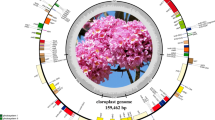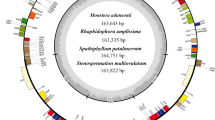Abstract
Background
Allium macranthum and Allium fasciculatum are two sister species and their natural populations are separated by high mountains and deep valleys with exact opposite habitat. The chloroplast genome in angiosperms has showed useful for investigating plant evolution and systematic studies.
Objective
Comparative analysis of these genomes revealed potential markers and phylogenetic analysis, and discuss the influence of positive selected sites on adaptive evolution.
Methods
Here, we sequenced the complete chloroplast genomes of these two species and analyzed the repeat sequences components, nucleotide diversity, selection pressure and the phylogeny relationships with related species.
Results
A typical quadripartite structure was detected with a genome size changed from 152,148 to 152,931 bp. We identified 67 and 79 simple sequence repeats in A. macranthum and A. fasciculatum, in which the mono-nucleotide repeats A/T possess the highest percentage. Three mutational hotspots (rpl32, rps16 and matK) at the SSC and LSC regions were observed, which showed remarkably higher Pi value (> 0.03). Additionally, eight genes (rpoA, atpF, cemA, rps4, ccsA, rpoC2, rpl14 and clpP) exhibited elevated pairwise Ka/Ks ratios in alpine species. Phylogenetic analyses based on the CDS sequences and the whole complete genomes showed same topologies with high support, and A. macranthum was closely clustered with A. fasciculatum within the fourteen Amaryllidaceae species.
Conclusion
Their coding proteins of these genes often functioned in chloroplast protein synthesis, gene transcription, energy transformation and regulation and photosynthesis. These results provide valuable insights into the alpine species adaptation and evolution.






Similar content being viewed by others
References
Altýnordu F, Peruzzi L, Yu Y, He XJ (2016) A tool for the analysis of chromosomes: karyotype. Taxon 65:586–592. https://doi.org/10.12705/653.9
Bastida JM, Alcántara JM, Rey PJ, Vargas P, Herrera CM (2010) Extended phylogeny of Aquilegia: the biogeographical and ecological patterns of two simultaneous but contrasting radiations. Plant Syst Evol 284:171–185. https://doi.org/10.1007/s00606-009-0243-z
Choi KS, Chung MG, Park S (2016) The complete chloroplast genome sequences of three Veroniceae species (Plantaginaceae): comparative analysis and highly divergent regions. Front Plant Sci 7:355. https://doi.org/10.3389/fpls.2016.00355
Daniell H, Lin CS, Yu M, Chang WJ (2016) Chloroplast genomes: diversity, evolution, and applications in genetic engineering. Genome Biol 17:134. https://doi.org/10.1186/s13059-016-1004-2
De Santis-Maciossek G, Kofer W, Bock A, Schoch S, Maier RM, Wanner G, Rudiger W, Koop H, Herrmann RG (2010) Targeted disruption of the plastid RNA polymerase genes rpoA, B and C1: molecular biology, biochemistry and ultrastructure. Plant J 18(5):477–489. https://doi.org/10.1046/j.1365-313X.1999.00473.x
Dong W, Liu J, Yu J, Wang L, Zhou S (2012) Highly variable chloroplast markers for evaluating plant phylogeny at low taxonomic levels and for DNA barcoding. PLoS ONE 7:e35071
Doyle JJ, Doyle JL (1987) A rapid DNA isolation procedure for small quantities of fresh leaf tissue. Phytochem Bul 19:11–15. https://doi.org/10.1371/journal.pone.0035071
Ellersiek U, Steinmuller K (1992) Cloning and transcription analysis of the ndh(A-I-G-E) gene cluster and the ndhD gene of the cyanobacterium Synechocystis sp. PCC6803. Plant Mol Biol 20(6):1097–1110
Fay JC, Wu C (2003) Sequence divergence, functional constraint, and selection in protein evolution. Annu Rev Genomics Hum Genet 4:213–235. https://doi.org/10.1146/annurev.genom.4.020303.162528
Friesen N, Fritsch RM, Blattner FR (2006) Phylogeny and intrageneric classification of Allium (Alliaceae) based on nuclear ribos omal DNA ITSsequences. Aliso 22:372–395. https://doi.org/10.5642/aliso.20062201.31
Fu J, Liu H, Hu J, Liang Y, Liang J, Wuyun T, Tan X (2016) Five complete chloroplast genome sequences from Diospyros: genome organization and comparative analysis. PLoS ONE 11:e0159566. https://doi.org/10.1371/journal.pone.0159566
Gu C, Tembrock LR, Zheng S, Wu Z (2018) The complete chloroplast genome of Catha edulis: a comparative analysis of genome features with related species. Int J Mol Sci 19:525. https://doi.org/10.3390/ijms19020525
Hanelt P, Fritsch RM (1994) Notes on some infrageneric taxa in Allium L. Kew Bull 49:559–564
Hong SY, Cheon KS, Yoo KO, Lee HO, Cho KS, Suh JT, Kim SJ, Nam JH, Sohn HB, Kim YH (2017) Complete chloroplast genome sequences and comparative analysis of Chenopodium quinoa and C. album. Front Plant Sci 8:1696
Hu Y, Woeste KE, Zhao P (2017) Completion of the chloroplast genomes of five Chinese Juglans and their contribution to chloroplast phylogeny. Front Plant Sci 7:1955. https://doi.org/10.3389/fpls.2016.01955
Huang DQ (2014) Molecular systematic of sect. Bromatorrhiza and its relationship with the Mediterranean Clade. In: He XJ (ed) Molecular systematic of Allium subgenus Cyathophora, sect. Bromatorrhiza and Sikkimensia (Amaryllidaceae) and intraspecific genetic differentiation of A. wallichii. Sichuan University, Chengdu, pp 45–65
Huotari T, Korpelainen H (2012) Complete chloroplast genome sequence of Elodea canadensis and comparative analyses with other monocot plastid genomes. Gene 508:96–105. https://doi.org/10.1016/j.gene.2012.07.020
Hurst LD (2002) The Ka/Ks ratio: diagnosing the form of sequence evolution. Trends Genet 18:486–487. https://doi.org/10.1016/S0168-9525(02)02722-1
Jian HY, Zhang SD, Zhang T, Qiu XQ, Yan HJ, Wang QG, Tang KX (2017) Characterization of the complete chloroplast genome of a critically endangered decaploid rose species, Rosa praelucens (Rosaceae). Conserv Genet Resour. https://doi.org/10.1007/s12686-017-0946-3
Jansen RK, Cai Z, Raubeson LA, Daniell H, Depamphilis CW, Leebensmack J, Müller KF, Guisinger-Bellian M, Haberle RC, Chumley TW, Lee S, Peery R, Mcneal JR, Kuehl JV, Boore JL (2007) Analysis of 81 genes from 64 plastid genomes resolves relationships in angiosperms and identifies genome-scale evolutionary patterns. Proc Natl Acad Sci USA 104:19369–19374. https://doi.org/10.1073/pnas.0709121104
Katoh K, Standley DM (2013) MAFFT multiple sequence alignment software version 7: improvements in performance and usability. Mol Biol Evol 30:772–780. https://doi.org/10.1093/molbev/mst010
Kearse M, Moir R, Wilson A, Stones-Havas S, Cheung M, Sturrock S, Buxton S, Cooper A, Markowitz S, Duran C (2012) Geneious basic: an integrated and extendable desktop software platform for the organization and analysis of sequence data. Bioinformatics 28:1647–1649. https://doi.org/10.1093/bioinformatics/bts199
Kim KJ, Lee HL (2004) Complete chloroplast genome sequences from Korean ginseng (Panax schinseng Nees) and comparative analysis of sequence evolution among 17 vascular plants. DNA Res 11:247–261. https://doi.org/10.1093/dnares/11.4.247
Kuang DY, Wu H, Wang YL, Gao LM, Zhang SZ, Lu L (2011) Complete chloroplast genome sequence of Magnolia kwangsiensis (Magnoliaceae): implication for DNA barcoding and population genetics. Genome 54:663–673. https://doi.org/10.1139/g11-026
Kumar S, Nei M, Dudley J, Tamura K (2008) MEGA: a biologist centric software for evolutionary analysis of DNA and protein sequences. Brief Bioinform 9:299–306. https://doi.org/10.1093/bib/bbn017
Li H, Durbin R (2009) Fast and accurate short read alignment with Burrows–Wheeler transform. Bioinformatics 25:1754–1760. https://doi.org/10.1093/bioinformatics/btp324
Li MJ, Guo XL, Li J, Zhou SD, Liu Q, He XJ (2017) Cytotaxonomy of Allium (Amaryllidaceae) subgenera Cyathophora and Amerallium sect. Bromatorrhiza. Phytotaxa 331(2):185–198. https://doi.org/10.11646/phytotaxa.331.2.3
Li QQ, Zhou SD, He XJ, Yu Y, Zhang YC, Wei XQ (2010) Phylogeny and biogeography of Allium (Amaryllidaceae: Allieae) based on nuclear ribosomal internal transcribed spacer and chloroplast rps16 sequences, focusing on the inclusion of species endemic to China. Ann Bot 106:709–733. https://doi.org/10.1093/aob/mcq177
Librado P, Rozas J (2009) DnaSP v5: a software for comprehensive analysis of DNA polymorphism data. Bioinformatics 25:1451–1452. https://doi.org/10.1093/bioinformatics/btp187
Liu HY, Yu Y, Deng YQ, Li J, Huang ZX, Zhou SD (2018) The chloroplast genome of Lilium henrici: genome structure and comparative analysis. Molecules 23:1276. https://doi.org/10.3390/molecules23061276
Lohse M, Drechsel O, Kahlau S, Bock R (2013) Organellar genome draw—a suite of tools for generating physical maps of plastid and mitochondrial genomes and visualizing expression data sets. Nucleic Acids Res 41:575. https://doi.org/10.1093/nar/gkt289
Makałowski W, Boguski MS (1998) Evolutionary parameters of the transcribed mammalian genome: an analysis of 2820 orthologous rodent and human sequences. Proc Natl Acad Sci USA 95:9407–9412
Powell W, Morgante M, McDevitt R, Vendramin GG, Rafalski JA (1995) Polymorphic simple sequence repeat regions in chloroplast genomes: applications to the population genetics of pines. Proc Natl Acad Sci USA 92:7759–7763. https://doi.org/10.1073/pnas.92.17.7759
Romanovsky YM, Tikhonov AN (2010) Molecular energy transducers of the living cell. Proton ATP synthase: a rotating molecular motor. Physics-Uspekh 53:931–956. https://doi.org/10.3367/UFNe.0180.201009b.0931
Ronquist F, Teslenko M, van der Mark P, Ayres DL, Darling A, Hohna S, Larget B, Liu L, Suchard MA, Huelsenbeck J (2012) MrBayes 3.2: efficient Bayesian phylogenetic inference and model choice across a large model space. Syst Biol 61:539–542. https://doi.org/10.1093/sysbio/sys029
Saina JK, Li ZZ, Gichira AW, Liao YY (2018) The complete chloroplast genome sequence of tree of heaven (Ailanthus altissima (mill.) (Sapindales: Simaroubaceae), an important pantropical tree. Int J Mol Sci 19:929. https://doi.org/10.3390/ijms19040929
Stamatakis A (2006) RAxML-VI-HPC: maximum likelihood-based phylogenetic analyses with thousands of taxa and mixed models. Bioinformatics 22:2688–2690. https://doi.org/10.1093/bioinformatics/btl446
Stearn WT (1960) Allium and Milula in the Central and Eastern Nepal Himalaya. Bull Br Museum Nat Hist (Botany) 2:159–191
Swofford DL (2003) PAUP∗. Phylogenetic analysis using parsimony (∗ and other methods). Version 4b10. Sinauer, Sunderland
Suo ZL, Li WY, Jin XB, Zhang HJ (2016) A new nuclear DNA marker revealing both microsatellite variations and single nucleotide polymorphic loci: a case study on classification of cultivars in Lagerstroemia indica L. J Microb Biochem Technol 8:266–271. https://doi.org/10.4172/1948-5948.1000296
Thiel T, Michalek W, Varshney R, Graner A (2003) Exploiting EST databases for the development and characterization of gene derived SSR-markers in barley (Hordeum vulgare L.). Theor Appl Genet 106:411–422. https://doi.org/10.1007/s00122-002-1031-0
Wang D, Liu F, Wang L, Huang S, Yu J (2011) Nonsynonymous substitution rate (Ka) is a relatively consistent parameter for defining fast-evolving and slow-evolving protein-coding genes. Biol Direct 6:13. https://doi.org/10.1186/1745-6150-6-13
Wu FH, Chan MT, Liao DC, Hsu CT, Lee YW, Daniell H, Duvall MR, Lin CS (2010) Complete chloroplast genome of Oncidium gower Ramsey and evaluation of molecular markers for identification and breeding in Oncidiinae. BMC Plant Biol 10:68. https://doi.org/10.1186/1471-2229-10-68
Wyler E, Wandrey F, Badertscher L, Montellese C, Alper D, Kutay U (2014) The beta-isoform of the BRCA2 and CDKN1A(p21)-interacting protein (BCCIP) stabilizes nuclear RPL23/uL14. FEBS Lett 588(20):3685–3691. https://doi.org/10.1016/j.febslet.2014.08.013
Wyman SK, Jansen RK, Boore JL (2004) Automatic annotation of organellar genomes with DOGMA. Bioinformatics 20:3252–3255. https://doi.org/10.1093/bioinformatics/bth352
Xie DF, Yu HX, Price M, Xie C, Deng YQ, Chen JP, Yu Y, Zhou SD, He XJ (2019) Phylogeny of Chinese Allium species in section Daghestanica and adaptive evolution of Allium (Amaryllidaceae, Allioideae) species revealed by the chloroplast complete genome. Front Plant Sci 10:460. https://doi.org/10.3389/fpls.2019.00460
Xie DF, Yu Y, Deng YQ, Li J, Liu HY, Zhou SD, He XJ (2018) Comparative analysis of the chloroplast genomes of the Chinese Endemic genus Urophysa and their contribution to chloroplast phylogeny and adaptive evolution. Int J Mol Sci 19:1847. https://doi.org/10.3390/ijms19071847
Xu JM (1980) Allium L. In: Flora reipublicae Popularis Sinicae, vol 14. Science Press, Beijing, pp 170–272
Xu JM, Kamelin RV (2000) Allium L. In: Wu ZY, Raven PH (eds) Flora of China, vol 24. Science Press, Missouri Botanical Garden Press, Beijing, St. Louis, pp 165–202
Yang Z, Bielawski JP (2000) Statistical methods for detecting molecular adaptation. Trends Ecol Evol 15:496–503. https://doi.org/10.1016/S0169-5347(00)01994-7
Yu W, Spreitzer RJ (1991) Sequences of trnR-ACG and petD that contain a tRNA-like element within the chloroplast genome of Chlamydomonas reinhardtii. Nucleic Acids Res 19(4):957
Yurina NP, Odintsova MS (1998) Comparative structural organization of plant chloroplast and mitochondrial genomes. Genetika 34:5–22
Acknowledgements
We acknowledge Xin Yang, Yan-ping Xiao, Wei Gou, and Xin-rui Xu for their help in materials collection and technical support. This work was supported by the National Natural Science Foundation of China (Grant nos. 31872647, 31570198), and the Specimen Platform of China, Teaching Specimen’s sub-platform (Available website: https://mnh.scu.edu.cn/), the Science and Technology Basic Work (Grant no. 2013FY112100).
Author information
Authors and Affiliations
Corresponding author
Ethics declarations
Conflict of interest
Authors do not have any conflict of interest to declare concerning to the present work.
Research involving with human and animal participants
This article does not contain any animal or human subjects in any studies of the authors. The plant materials are not in the endangered species list.
Data archiving statement
The complete cp genomes of A. macranthum and A. fasciculatum were submitted to the GenBank under the accession numbers MK251466 and MK251467. A full list of accession numbers in this article is included at Supplementary Table S9.
Additional information
Publisher's Note
Springer Nature remains neutral with regard to jurisdictional claims in published maps and institutional affiliations.
Electronic supplementary material
Below is the link to the electronic supplementary material.
Rights and permissions
About this article
Cite this article
Li, H., Xie, DF., Chen, JP. et al. Chloroplast genomic comparison of two sister species Allium macranthum and A. fasciculatum provides valuable insights into adaptive evolution. Genes Genom 42, 507–517 (2020). https://doi.org/10.1007/s13258-020-00920-0
Received:
Accepted:
Published:
Issue Date:
DOI: https://doi.org/10.1007/s13258-020-00920-0




